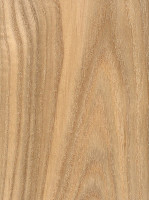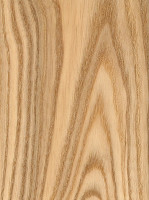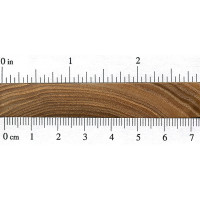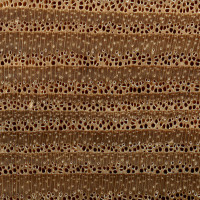 |
Common Name(s): Black Ash Scientific Name: Fraxinus nigra Distribution: Northeastern United States and Eastern Canada Tree Size: 50-65 ft (15-20 m) tall, 1-2 ft (.3-.6 m) trunk diameter Average Dried Weight: 34 lbs/ft3 (545 kg/m3) Specific Gravity (Basic, 12% MC): .45, .55 Janka Hardness: 850 lbf (3,780 N) Modulus of Rupture: 12,600 lbf/in2 (86.9 MPa) Elastic Modulus: 1,600,000 lbf/in2 (11.00 GPa) Crushing Strength: 5,970 lbf/in2 (41.2 MPa) Shrinkage: Radial: 5.0%, Tangential: 7.8%, Volumetric: 15.2%, T/R Ratio: 1.6 |
Color/Appearance: The heartwood is a light to medium brown color. Sapwood can be very wide, and tends to be a beige or light brown; not always clearly or sharply demarcated from heartwood. Black Ash tends to be a bit darker in color than White Ash (Fraxinus americana).
Grain/Texture: Has a medium to coarse texture similar to oak. The grain is almost always straight and regular, though sometimes curly or figured boards can be found.
Endgrain: Ring-porous; large earlywood pores 2-4 rows wide, small latewood pores solitary and radial multiples; tyloses common; parenchyma banded (marginal), parenchyma around latewood pores less common in Black Ash, but may be vasicentric, winged and confluent; narrow rays, spacing normal.
Rot Resistance: Heartwood is rated as perishable, or only slightly durable in regard to decay. Ash is also not resistant to insect attack.
Workability: Produces good results with hand or machine tools. Responds well to steam bending. Glues, stains, and finishes well.
Odor: Gives off a distinct, moderately unpleasant smell when being worked.
Allergies/Toxicity: Ash in the Fraxinus genus has been reported to cause skin irritation, and a decrease in lung function. See the articles Wood Allergies and Toxicity and Wood Dust Safety for more information.
Pricing/Availability: Ash is among the least expensive utility hardwoods available domestically; it should compare similarly to oak in terms of price.
Sustainability: This wood species is not listed in the CITES Appendices, but is on the IUCN Red List. It is listed as critically endangered due to a projected population reduction of over 80% in the next three generations, caused by effects of introduced taxa. (See notes on the emerald ash borer in the comments section below.)
Common Uses: Flooring, millwork, boxes/crates, baseball bats, and other turned objects such as tool handles.
Comments: The emerald ash borer (Agrilus planipennis), believed to have been inadvertently introduced from Asia sometime in the 1990s, was first detected in Michigan in 2002. Lacking natural predators, uncontrolled populations of this invasive species spread very rapidly throughout North America, devastating local populations of ash trees. The beetles’ larvae bore into a tree and feed on the inner bark, eventually killing the entire tree. The insects are responsible for the deaths of hundreds of millions of ash trees across the United States and Canada. Green Ash and Black Ash trees are preferentially attacked by the insects, followed by White Ash and Blue Ash.
Black Ash is one of a handful of species in the Fraxinus genus that are used as commercial lumber. It’s not quite as strong or dense as the related White Ash (Fraxinus americana); this is most likely due to its slower growth rate, which causes a higher proportion of weaker earlywood sections. The closer ring spacing can also be used to distinguish Black Ash from White Ash. (This lack of density is favored for use in electric guitar bodies, and the term “Swamp Ash” is used loosely to describe pieces of ash that have low densities and good acoustic properties.)
Black Ash is commonly used in basket weaving. The endgrain of the wood is pounded with a mallet—collapsing the weaker earlywood, and liberating the latewood to be peeled off in strips. The strips are subsequently collected and woven into baskets.
When stained, ash can look very similar to oak (Quercus spp.), although oaks have much wider rays, which are visible on all wood surfaces—even on flatsawn surfaces, where they appear as short, thin brown lines between the growth rings. Ashes lack these conspicuous rays.








I have my own mI’ll and just cut a fresh black ash tree if you want a specific size let me know I can get it.
Minnesota is a good source if you look on craigslist.